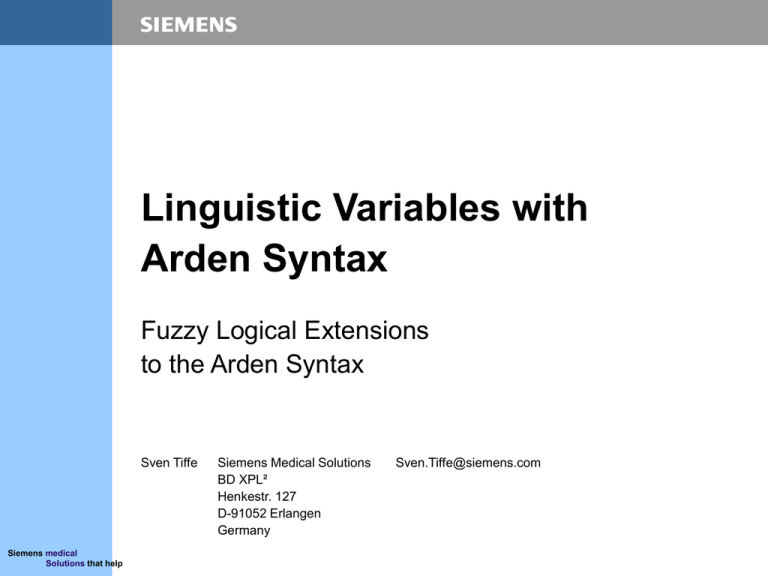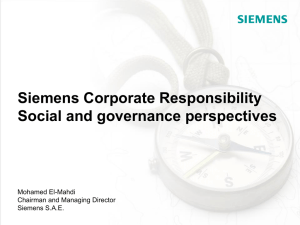
Linguistic Variables with
Arden Syntax
Fuzzy Logical Extensions
to the Arden Syntax
Sven Tiffe
Siemens medical
Solutions that help
Siemens Medical Solutions
BD XPL²
Henkestr. 127
D-91052 Erlangen
Germany
Sven.Tiffe@siemens.com
2
Proposed extensions – so far
Extensions based on fuzzy theoretical concepts
Comparison operators:
fuzzy comparison by
one or two additional
parameters (binary or
ternary operators)
Truth values: gradual transition from false to true
Arden operators: every operator is can handle data with
“fuzziness” or fuzzy truth values
Siemens medical
Solutions that help
Sven Tiffe, MED BD XPL², Sven.Tiffe@siemens.com
© 2001 Siemens Medical Solutions
Data types: additional attribute “fuzziness” to measure fuzzy
context of data creation
3
Capabilities – so far
Fuzzily defined selection criteria and conditions by fuzzy
comparison operators
Processing of measured “fuzziness”
Fuzzy if-then statements
Fuzzy logical operators
Aggregation operators
Fuzzy sets for fuzzy comparisons have to be defined each
time they are used
Siemens medical
Solutions that help
Sven Tiffe, MED BD XPL², Sven.Tiffe@siemens.com
© 2001 Siemens Medical Solutions
Defuzzification
4
Concept of Linguistic Variables
Description of the relationship between abstract concepts
(terms) and (numeric) data
Name of linguistic variable
Values (terms) described by fuzzy set
(1) pronounced hypothermia
(2) deep hypothermia
(3) moderate hypothermia
(4) slight hypothermia
(5) normal
(6) subfebrile
(7) moderate fever
(8) high fever
Independent from terminology
Siemens medical
Solutions that help
Sven Tiffe, MED BD XPL², Sven.Tiffe@siemens.com
© 2001 Siemens Medical Solutions
Example: “temperature”
5
Usage
Usable as linguistic expressions in algorithms, e.g.:
Siemens medical
Solutions that help
if temperature is ’subfebrile’ then
if weight is ’normal’ and blood_pressure is ’increased’
then
Sven Tiffe, MED BD XPL², Sven.Tiffe@siemens.com
© 2001 Siemens Medical Solutions
Evaluation in TOSCA project in addition to a commercial
fuzzy control system
Auhtors: G. Zahlmann, Siemens, and M. Scherf, GSF
Fuzzy control systems
6
Representation using fuzzy comparisons
“temperature is normal” could be defined as:
temp_sf := temp is within 36.8 fuzzified by 0.8 to 37.1 fuzzified by 0.5;
The fuzzy set has to be (re)defined for every usage.
Define linguistic variable separately:
temp := liguistic variable ‘temperature’;
And compare to term instead compare to numeric values:
Siemens medical
Solutions that help
Sven Tiffe, MED BD XPL², Sven.Tiffe@siemens.com
© 2001 Siemens Medical Solutions
temp_sf := temp is ‘normal;
7
Representation as MLM
Each linguistic variable represented by one MLM
Slots in knowledge category:
type: linguistic variable
values: single terms of LV as Arden terms
input: input value(s) for this variable
• numerical data from read statement
• linguistic variable as result from other MLMs
defuzzification: method for defuzzification (optional)
unit: natural language unit of (numeric) data as Arden term
sets: fuzzy sets for every single term
Siemens medical
Solutions that help
Sven Tiffe, MED BD XPL², Sven.Tiffe@siemens.com
© 2001 Siemens Medical Solutions
range: range of valid (numerical) input/output value
8
Example linguistic variable
Linguistic variable “Intraocular Pressure (IOP)”
m(x)
increased
0.0
0
10
20
30
40
knowledge:
type: linguistic variable;;
values: 'normal', 'increased';;
input: read { %event.iop_value:iop_time% };;
range: 0.0, 70.0;;
unit: 'mmHg';;
sets:
normal:= linear((0.0, 1.0), (20.0, 1.0), (22.07, 0.0), (70.0, 0.0));
increased:= linear((0.0, 0.0), (20.0, 0.0), (22.07, 1.0), (70.0, 1.0));;
Siemens medical
Solutions that help
Sven Tiffe, MED BD XPL², Sven.Tiffe@siemens.com
mmHg
© 2001 Siemens Medical Solutions
normal
1.0
9
Usage – declaration
Input variables are initialized: input slot gets executed in
these MLMs
CDR := init linguistic variable 'LV_CDR';
diff_lr := init linguistic variable 'LV_diff_lr';
IOP := init linguistic variable 'LV_IOP';
le
:= init linguistic variable 'LV_le';
Output variables are not initialized
Siemens medical
Solutions that help
Sven Tiffe, MED BD XPL², Sven.Tiffe@siemens.com
© 2001 Siemens Medical Solutions
normotens_glauco := linguistic variable 'LV_ normotens_glauco’;
10
Usage – evaluation, value assignment
Comparison between linguistic variable and term
<id> IS <term>
returns a fuzzy truth value
Assign term to a linguistic variable (with optional weight)
SET <id> TO <term> (WITH <number>)
Value is influenced by “fuzziness” of code block (condition)
if (CDR is ‘normal' and diff_lr is 'normal' and IOP is 'normal‘
and le is ‘centered’) then
endif;
Get numerical value by defuzzification
DEFUZZIFY <id>
Siemens medical
Solutions that help
Sven Tiffe, MED BD XPL², Sven.Tiffe@siemens.com
© 2001 Siemens Medical Solutions
set normotens_glauco to ‘nowith 1.0;
11
knowledge:
type: data-driven;;
data: (CDR, diff_lr, IOP, le) := argument;
if CDR is null then /* if module not used with arguments */
CDR := init linguistic variable 'LV_CDR';
diff_lr := init linguistic variable 'LV_diff_lr';
IOP := init linguistic variable 'LV_IOP';
le
:= init linguistic variable 'LV_le';
endif;
normotens_glauco := linguistic variable 'LV_normotens_glauco';
;;
evoke: /* direct call */;;
logic: if (CDR is 'normal' AND diff_lr is 'normal' AND IOP is 'normal' AND le is 'centered') then
set normotens_glauco to 'no' with 1.0;
endif;
if (CDR is 'normal' AND diff_lr is 'normal' AND IOP is 'normal' AND le is 'tempinferior') then
set normotens_glauco to 'yes' with 0.398;
endif;
if (CDR is 'normal' AND diff_lr is 'normal' AND IOP is 'normal' AND le is 'tempsuperior') then
set normotens_glauco to 'yes' with 0.398;
endif;
…
…
Siemens medical
Solutions that help
Sven Tiffe, MED BD XPL², Sven.Tiffe@siemens.com
© 2001 Siemens Medical Solutions
Example: Rule block in DIADEM project
12
Evaluation
[1] MC Jaulent, et.al., Modeling uncertainty in computerized guidelines using fuzzy logic, proceedings of AMIA symposium 2001
Siemens medical
Solutions that help
Sven Tiffe, MED BD XPL², Sven.Tiffe@siemens.com
© 2001 Siemens Medical Solutions
CADIAG-II/RHEUMA: expert system with large knowledge
base (about 3000 MLMs); using basically fuzzy
comparisons and logical operators, but is based (and thus
extendable) on linguistic variables
TOSCA: fuzzy control rule set for glaucoma screening, 17
linguistic variables and 11 production rule blocks; using
linguistic variables
Hypertension guideline (University Pierre & Marie Curi,
Medical School, Paris); using fuzzy comparisons [1]
13
Conclusion – Linguistic Variables
Pluses
Formalization of relationship between terms and data
Centralized definition
Arden knowledge bases describe relationship between data
and linguistic concepts, independently from terminology
No need to define fuzzy sets in each MLM, where the fuzzy
set (term) is used
Additional data type – how shall Arden operators handle
these variable? (similar problem to usage of “object”
variables) So far, no additional operator uses these values.
Siemens medical
Solutions that help
Sven Tiffe, MED BD XPL², Sven.Tiffe@siemens.com
© 2001 Siemens Medical Solutions
Minuses
14
Summary
Integration fuzzy theoretical concepts
Fuzzy comparison operators (applying concept of fuzzy sets)
Fuzzy truth values
Linguistic variables
Large knowledge bases in different projects (CADIAG,
DIADEM)
Small knowledge bases or single rules have still to be defined
Siemens medical
Solutions that help
Sven Tiffe, MED BD XPL², Sven.Tiffe@siemens.com
© 2001 Siemens Medical Solutions
Not a fuzzy mathematical framework – only slight
modifications to the programming language
Yes, it runs!
Evaluation
15
Summary, cont.
Other uncertainty models
“Fuzzy logic” is not the only model to represent uncertainty
(probabilistic approaches, Demster-Shafer, neuronal nets)
But: fuzzy logical extensions are easy embeddable in a
procedural and rule based environment like Arden
Additional data attribute “uncertainty” has to be handled by
every operator
Linguistic variables result in an entirely new data type
• Do not modify operators and ignore these data types
Similar problem: introduction of object oriented data types
Siemens medical
Solutions that help
Sven Tiffe, MED BD XPL², Sven.Tiffe@siemens.com
© 2001 Siemens Medical Solutions
• Extension of every single operator
16
Outlook
Context dependent linguistic variables
Crisp fuzzy set selection by selection criteria (e.g., sex,
pregnancy)
Two-dimensional fuzzy sets
• fuzzy sets are dependent on fuzzily defined patient age range
Siemens medical
Solutions that help
Sven Tiffe, MED BD XPL², Sven.Tiffe@siemens.com
© 2001 Siemens Medical Solutions
Results of evaluation
Backup slides
Siemens medical
Solutions that help
18
Example: fuzzy fan control
Production rules:
If temperature is cool set speed to slow
If temperature is moderate set speed to medium
If temperature is hot set speed to fast
Linguistic variables:
Linguistic variable “temperature”
Linguistic variable “speed”
1.0
m(x)
cool
moderate
hot
1.0
0.0
10
Siemens medical
Solutions that help
20
30
40
°C
slow
medium
fast
1000
2000
3000
0.0
Sven Tiffe, MED BD XPL², Sven.Tiffe@siemens.com
4000
RPM
© 2001 Siemens Medical Solutions
m(x)
19
Fan control: input fuzzification
Assume, measured temperature is 28°C
Linguistic variable “temperature”
m(x)
cool
moderate
hot
0.0
10
20
30
40
°C
Temperature is cool: 0.00
Temperature is moderate: 0.40
Temperature is hot: 0.60
Siemens medical
Solutions that help
Sven Tiffe, MED BD XPL², Sven.Tiffe@siemens.com
© 2001 Siemens Medical Solutions
1.0
20
Fan control: production rules
If temperature is cool set speed to slow
Linguistic variable “temperature”
Linguistic variable “speed”
1.0
m(x)
cool
moderate
hot
1.0
0.0
10
20
30
40
°C
slow
medium
fast
1000
2000
3000
0.0
4000
RPM
As temperature is definitely not cool, speed has not value
slow
Siemens medical
Solutions that help
Sven Tiffe, MED BD XPL², Sven.Tiffe@siemens.com
© 2001 Siemens Medical Solutions
m(x)
21
Fan control: production rules
If temperature is moderate set speed to medium
Linguistic variable “temperature”
Linguistic variable “speed”
m(x)
1.0
m(x)
cool
moderate
hot
1.0
0.0
10
20
30
40
°C
slow
medium
fast
1000
2000
3000
0.0
4000
RPM
Siemens medical
Solutions that help
Sven Tiffe, MED BD XPL², Sven.Tiffe@siemens.com
© 2001 Siemens Medical Solutions
Speed is set to medium by a degree of 0.40
22
Fan control: production rules
If temperature is hot set speed to fast
Linguistic variable “temperature”
Linguistic variable “speed”
m(x)
1.0
m(x)
cool
moderate
hot
1.0
0.0
10
20
30
40
°C
slow
medium
fast
1000
2000
3000
0.0
4000
RPM
Siemens medical
Solutions that help
Sven Tiffe, MED BD XPL², Sven.Tiffe@siemens.com
© 2001 Siemens Medical Solutions
Speed is set to fast by a degree of 0.60
23
Fan control: output value
The output variable “speed” has the value (0.0, 0.4, 0.6)
Linguistic variable “speed”
m(x)
slow
medium
fast
1000
2000
3000
0.0
4000
RPM
In order to control the fan speed, the linguistic variable has
to be defuzzified
Siemens medical
Solutions that help
Sven Tiffe, MED BD XPL², Sven.Tiffe@siemens.com
© 2001 Siemens Medical Solutions
1.0
24
Fan control:
defuzzification
Center of Gravity:
2600,1 RPM
Center of Maximum:
2600 RPM
Mean of Maximum:
The examples have been
computed using
fuzzyTECH® 5.51
Siemens medical
Solutions that help
Sven Tiffe, MED BD XPL², Sven.Tiffe@siemens.com
© 2001 Siemens Medical Solutions
3000 RPM
25
Siemens medical
Solutions that help
Sven Tiffe, MED BD XPL², Sven.Tiffe@siemens.com
© 2001 Siemens Medical Solutions
Fan control:
sample MLMs
26
Siemens medical
Solutions that help
Sven Tiffe, MED BD XPL², Sven.Tiffe@siemens.com
© 2001 Siemens Medical Solutions
Fan control:
sample MLMs
27
Siemens medical
Solutions that help
Sven Tiffe, MED BD XPL², Sven.Tiffe@siemens.com
© 2001 Siemens Medical Solutions
Fan control:
sample MLMs
28
Siemens medical
Solutions that help
Sven Tiffe, MED BD XPL², Sven.Tiffe@siemens.com
© 2001 Siemens Medical Solutions
Fan control:
sample MLMs






